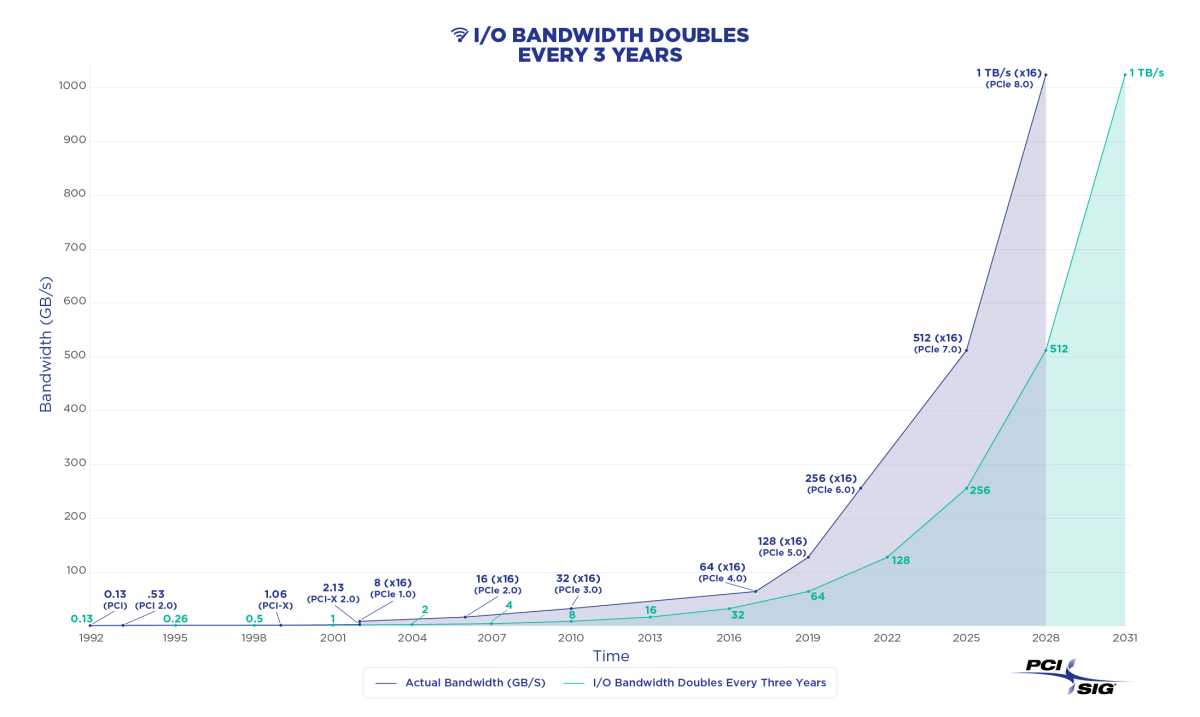As expected, by 2028 your PC will be internally passing a terabyte’s worth of data per second as part of PCI Express 8.0.
The PCI Special Interest Group said Tuesday that the PCIe 8 specification is due to be released in 2028, with speeds of 256 gigatransfers per second. In real-world terms, that works out to 1 terabyte per second being passed over a x16 connection via the PCI Express 8.0 bus.
The new data rate should come as no surprise, as the SIG has consistently released iterative PCI Express standards that double the available bandwidth about every three years. In June, the PCIe SIG formally announced the PCI Express 7 specification, projected to be released in 2027. At that time, the SIG disclosed the existence of PCIe 8 without the bandwidth data, but the projection was easy enough to make.
The timing of it all can be a bit confusing. Practically, the fastest PCI Express devices currently available for the PC, such as the fastest PC SSDs, use the PCI Express 5 protocol — 128GB/s at x16 speeds. Last week, the first PCI Express 6.0 SSD shipped: the Micron 9650, which can hypothetically process 256GB/s at a time. (They can’t, in reality. The drive reads of up to 28,000 MB/s — which is roughly 13 percent under the peak PCIe 6.0 bandwidth, with sequential writes of 14,000 MB/s.)
The graphic below shows the progression of PCI Express speeds, but also hints as the hypothetical limits of certain components, too. SSDs typically use a x4 interface, so they’ll have a maximum hypothetical data rate of 256GB/s under PCI Express 8, versus the 32GB/s they operate under with the current PCI Express 5. Graphics cards, conversely, use a x16 connection, meaning that PCIe 8 will supply about seven times more bandwidth than it does today.

PCI-SIG
The Micron 9650, however, is aimed at data centers, not the PC. Micron’s release of the 9650 coincides with our report that the PCI Express 6.0 integrator’s list of actual PCIe 6 hardware will be released this year, though data centers and AI may gobble up all of the available hardware. Silicon Motion’s CEO told Tom’s Hardware that the company doesn’t expect PCI Express 6.0 to appear in PCs for a few years.
That’s what the PCIe SIG is saying for the first PCIe 8.0 devices, too: they’ll be used for artificial intelligence and machine learning first and foremost, then high-speed networking and quantum computing.
“As artificial intelligence and other data-intensive applications continue to scale rapidly, PCIe technology demand will be sustained in the long run due to its high bandwidth, scalability and power efficiency,” said Reece Hayden, principal analyst at ABI Research, as quoted by the PCI-SIG. “Data center networks are already preparing to implement PCIe 6.0 technology and are showing great interest in the PCIe 7.0 specification. The introduction of the PCIe 8.0 specification further ensures that the industry’s bandwidth requirements will be supported well into the future.”

PCI-SIG
A terabyte’s worth of bandwidth, though, is no joke, and neither are the thermal issues that come with it. The two key problems that need to be addressed are when AMD, Intel, and Qualcomm plan to add PCI Express 6 to their PC roadmaps — let alone 7 or 8 — and how device makers will deal with the corresponding increase in heat that the increased bandwidth will bring with it.
Войдите, чтобы добавить комментарий
Другие сообщения в этой группе

Interest in Sonos’s smallest portable speaker is heating up—literally

Free alternatives may exist for Microsoft Office components, but some

E-commerce giant Amazon is now expanding its automotive business to i


Want ad-free streaming without paying through the nose for Netflix or

Microsoft is reportedly testing a new feature in the taskbar called “

I spend a lot of time searching Amazon listings. In addition to stand
